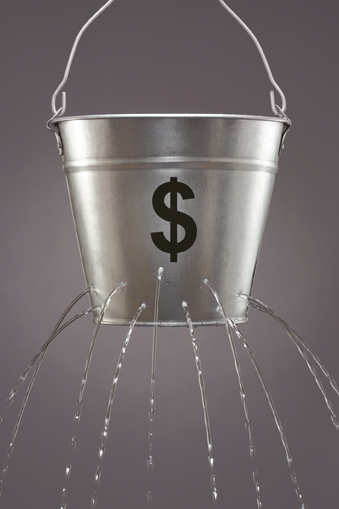Management by Coaching
Six ways you give up control and what you can do about it
You know the routine. On the ride into the office, you scan your mental to-do list, figure out your priorities, and start mapping out your day. You feel organized and in control. Then, you get to the office. You’re barely through the front door, and a stressed looking colleague grabs you saying she desperately needs your help on a big account that has to go to the insurer right away. You respond. Crisis number one dealt with; your cell vibrates in your pocket for the fourth time. It’s your daughter. She forgot her lacrosse equipment and will miss today’s playoff game if you can’t get her “stuff” to school this morning. As you check your calendar in search of the 45 minutes you’ll need to get to school and back, 78 new emails flood your inbox. So much for your good intentions and planning.
A recent Harvard Business School study showed that the average knowledge worker maintains focus for only seven minutes before needing to check his or her phone/messages.
Maintaining control isn’t easy. We live in an era of increasing demands and decreasing levels of patience. People want what they want, and they want it now. Whether out of conscientiousness, the need to please others, or fear, most of us feel an intense pressure to oblige. Our work world is filled with triggers like these that impact our behavior and, when left unchecked, derail our best-laid plans.
Is control possible?
Most of us know that the idea of having total control of anything in our lives is an illusion. While it seems wise on the surface to have this belief, the danger is that we begin to think and act as if we have no control. That, too, is an illusion. In truth, we have a tremendous amount of control. The problem is that we squander it. See if any of these behaviors rings true for you:
- Believe that things will be better tomorrow—How often do you leave the office at the end of the day feeling frustrated that you didn’t accomplish everything you wanted? There was so much going on that the day simply got away from you. You review all of the crises that hit your desk and excuse yourself by chalking it off as a crazy day. You vow that tomorrow will be better. You’ll get in early, be better organized and stay focused. But when tomorrow comes, it tends to be pretty much the same as yesterday. Where we miss the boat is that we act as if the crazy days are the exception when in reality they’re the norm.
- Underestimate the power of our environment—Keeping the maximum control means understanding that our environment is the most potent trigger in our lives. The smell of the delicious porterhouse steak sizzling on the grill makes us ignore our goal to cut back on red meat. Our colleague is working late to finish up a new business pitch, and our guilt about being seen as a slacker leads us to miss another family dinner. Our environment continuously intervenes and shapes our behavior. We need to recognize it for the adversary it is and plan accordingly.
Marshall Goldsmith, executive coach to Fortune 500 CEOs and author of the book Triggers, recommends a three-point strategy: anticipate, avoid and adapt.
Anticipate—If you were about to make a big sales presentation, hold an employee town meeting or ask for a raise, you’d hone your story, rehearse and anticipate the objections. That’s because when it’s really important, we’re good at anticipating. Apply the same principle to your day. Anticipate how you want your day to go. Visualize it and lock it in your mind. Then consider the obstacles that might get in the way. Think through how you will deal with them.
Avoid—Sometimes our smartest response to the environment is to avoid it. This is easy when it comes to avoiding something negative, like a person you don’t like, but not so easy when it’s something pleasurable. Let’s say you like negotiating deals with insurance companies but it’s not really your job; it’s the marketing department’s. Once involved, you keep getting phone calls and emails that get in the way of your real responsibilities. In this case, avoiding means not wandering into the marketing department in the first place. Once engaged, you’ll find it hard to stop.
Adjust—Some things in the environment can’t be changed or avoided. This is when we have to adjust. For example, if you’re a person who needs quiet to concentrate and you work in an open-plan office where people are constantly talking, buy yourself a pair of noise-cancelling headphones.
If you don’t take steps to control and regulate your environment, it will control you.
- Let others dictate our agenda—A direct report needs your help on a technology problem. A colleague calls an emergency meeting. You learn that one of your key accounts is shopping their business and the producer wants you to be there when he meets with the client later in the day. It feels like everything is a priority. If you’re like most professionals, much of your day is spent in reactive mode, putting the needs of others ahead of your agenda.
Some of this is unavoidable, but much is avoidable. We get sucked in because we don’t have a daily navigation system that keeps us centered on our priorities and where our real value to the business lies. Sure, we have a to-do list that we try to prioritize every day. But are we doing the right things? Are we just busy or are we doing the things that move the needle on our performance and contribution to the business?
A tool I find extremely helpful is the “Enhanced To-Do List.” This goes beyond a conventional “to-do” list by adding three additional components. This is where the magic lies.
First, the list includes your “Values.” These are the qualities that you believe are important in the way you live and work. Whether we recognize these values or not, our level of satisfaction is pretty much tied to how closely our lives align with our values. The day flows far more smoothly when we acknowledge our values and make plans and decisions that honor them.
Second, The Enhanced To-Do List includes your big-picture goals. These are the important, longer-term goals you really want to accomplish. They can be both professional and personal. If you look at your values and big-picture goals when you build your daily to-do list, you begin to make better decisions about how to prioritize and how to best use your time.
The third element is the “Gut Check.” At the end of each day, consider your accomplishments. Did you get what you needed to get done? Did you take action to make progress towards your big-picture goals? Did you behave in accordance with your values? Knowing you will hold yourself accountable at the end of each day will keep you focused and extremely conscious of how you use time. If you’d like a free copy of the Enhanced To-Do List, just email kpaterson@cim-co.com.
- Allow ourselves to be victims of distraction—We may think we hate distractions, but the fact is that our brains like them. Our brain’s reward circuit lights up when we multi-task; in other words, we get an emotional high when we do multiple things at once. This is supported by a recent Harvard Business School study that showed that the average knowledge worker maintains focus for only seven minutes before needing to check his or her phone/messages.
Over time, we’ve lost the ability to focus. Whether the distractions come from others or from within, distraction has become our norm. It is stealing huge chunks of valuable time from our day.
Getting better control over your day requires strengthening your ability to focus. Try this experiment. See how long you can stay focused on a single task that requires real concentration before becoming distracted. If this is hard for you, use this time as your baseline and gradually work your way up to longer periods of time. With practice, you’ll get better and better.
Build focus time into your day. Explain to your colleagues what you’re doing and why. During focus time, turn off the email, instant messaging and phone. Shut the door. If you work in an open-plan office, create your own quiet zone. Put on your head-phones. Invest in your own version of a “do not disturb sign.” It can be fun or serious—whatever best reflects your style. To avoid being viewed as inaccessible, be sure to include a note on when you’ll be available and don’t overuse your sign.
- Resist saying no—Whether it’s getting sidetracked by going after that big account that we have little-to-no chance of winning or saying “yes” to one more request when we’re already in the weeds, many of us have a hard time saying “no.” Typically, we respond quickly without thinking and our default response is to say “yes.” These decisions take precious time away from our priorities.
Let go of your fear of disappointing others and fear of missing out on opportunities. Think carefully before you say “yes.” Learn to say “no” with tact and diplomacy.
- Sacrifice the important for the expedient—How many times do you start with the quick or easy items on your to-do list so you can get them out of the way and then get down to the important tasks? But then as fast as you check these quick items off the list, new ones surface. Before you know it, it’s 4 p.m. and you haven’t gotten to the significant projects yet. You leave feeling frustrated. You worked hard all day but you didn’t get to the items that really matter.
Flip it. Use your first couple of hours of the day for the significant and typically harder items on your list. If you’re like most people, these are your peak performance hours. Tackling tasks that require focus and concentration during your peak time will make the work easier and your quality will be better. Regardless of what happens the rest of your day, you’ll leave work knowing you accomplished something important.
Finding self-control in an out-of-control world
The faster the world around us spins, the more important our self-control becomes. Because when we don’t have good control over ourselves or circumstances, someone else will always have the power over us. Getting better control of your day begins and ends with getting better control over you.
The author
Kimberly Paterson, CEC and Certified Energy Leadership Coach, is president of CIM (www.cim-co.com), a marketing and consulting firm that works with property & casualty insurance agencies and company clients. She can be reached at kpaterson@cim-co.com






